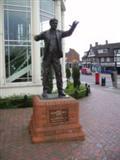 Perhaps the most obvious and sweeping change that has affected the first part of the 20th century has been the rapid advance of technology. Radio and television broadcasting, records and compact discs have changed musical life beyond imagination. Music has now become a commodity, readily available anywhere. Â
Perhaps the most obvious and sweeping change that has affected the first part of the 20th century has been the rapid advance of technology. Radio and television broadcasting, records and compact discs have changed musical life beyond imagination. Music has now become a commodity, readily available anywhere. Â
Against this background of change and development, although traditional sounds of classical music still persist, experiments using these new methods occurred in the early part of the 20th century.
This period saw the dawning of "atonality" and the "twelve-tone" system. In effect, the term "atonal" describes music that does not conform to the system of tonal hierarchies that characterized classical music between the 17th and 19th centuries.
AtonalityÂ
An important aspect of 20th century music concerns new ideas of tonality. Whereas tonality refers to music in which a specific pitch relationships are based on a key "center," atonality is to write music that's not in any key at all or without any key or tonal center. This is called "atonal" music or sometimes referred to as "serial" especially in relation to the "twelve-tone" system.Â
These compositions were written from the early 20th century, about 1907, where a hierarchy of pitches focusing on a single, central tone (or key) was not used as a primary foundation for the work. Â
Twelve-tone System
The primary technique used in writing atonal music has been the twelve-tone system, in which the 12 notes of the chromatic scale are used. The composer chooses the notes either at random or according to guidelines; they are then used once each in a row. As soon as the 12 notes have been used, the same series begins again.
Second Viennese School
The Second Viennese School is a term used for the group of composers in the early 20th century Vienna, who adopted and developed the twelve-note system composition. In particular, the three leading proponents of this system:Â Arnold Schoenberg (1874-1951) and two of his pupils who further developed it, Alban Berg (1885-1935) and Anton Webern (1883-1945.)
Polytonality
One of the more extreme experiments used two or more keys at the same time. This was called polytonality. Other composers broke away from the standard major and minor scales and used the mode developed in medieval church music. Composers such as Ralph Vaughan-Williams and Maurice Ravel have written music like this, called neo-modal music.
Examples of atonal and 12-tone music:
Schoenberg's Five Pieces for Orchestra, Opus 16 (atonal)
Schoenberg's excerpts from Pierrot lunaire, Opus 21 (atonal)Â Â
Schoenberg's Violin Concerto, Opus 36 (12-tone)
Schoenberg's Piano Concerto, Opus 42 (12-tone)
Berg's Chamber Concerto
Berg's Lyric Suite
Webern's Three Traditional Rhymes
Webern's String Trio
